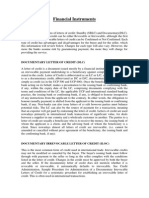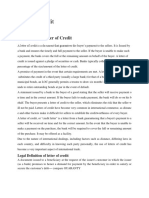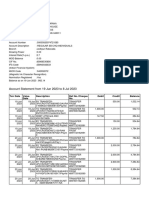Letter of Credit: Navigation Search
Letter of Credit: Navigation Search
Uploaded by
Girish SakhalkarCopyright:
Available Formats
Letter of Credit: Navigation Search
Letter of Credit: Navigation Search
Uploaded by
Girish SakhalkarOriginal Title
Copyright
Available Formats
Share this document
Did you find this document useful?
Is this content inappropriate?
Copyright:
Available Formats
Letter of Credit: Navigation Search
Letter of Credit: Navigation Search
Uploaded by
Girish SakhalkarCopyright:
Available Formats
Letter of credit
From Wikipedia, the free encyclopedia Jump to: navigation, search
After a contract is concluded between buyer and seller, buyer's bank supplies a letter of credit to seller
Seller consigns the goods to a carrier in exchange for a bill of lading.
Seller provides bill of lading to bank in exchange for payment. Seller's bank exchanges bill of lading for payment from buyer's bank. Buyer's bank exchanges bill of lading for payment from the buyer.
Buyer provides bill of lading to carrier and takes delivery of goods. A letter of credit is a document that a financial institution or similar party issues to a seller of goods or services which provides that the issuer will pay the seller for goods or services the seller delivers to a third-party buyer.[1] The issuer then seeks reimbursement from the buyer or from the buyer's bank. The document serves essentially as a guarantee to the seller that it will be paid by the issuer of the letter of credit regardless of whether the buyer ultimately fails to pay. In this way, the risk that the buyer will fail to pay is transferred from the seller to the letter of credit's issuer. Letters of credit are used primarily in international trade for large transactions between a supplier in one country and a customer in another. In such cases, the International Chamber of Commerce Uniform Customs and Practice for Documentary Credits applies (UCP 600 being the latest version).[2] They are also used in the land development process to ensure that approved public facilities (streets, sidewalks, storm water ponds, etc.) will be built. The parties to a letter of credit are the supplier, usually called the beneficiary, the issuing bank, of whom the buyer is a client, and sometimes an advising bank, of whom the beneficiary is a client. Almost all letters of credit are irrevocable, i.e., cannot be amended or canceled without the consent of the beneficiary, issuing bank, and confirming bank, if any. In executing a transaction, letters of credit incorporate functions common to giros and traveler's cheques.
Contents
1 Terminology o 1.1 Origin of the term o 1.2 Types and related terms 2 Documents that can be presented for payment 3 Legal principles governing documentary credits 4 Different Types of Letter of Credit 5 The price of letters of credit
6 Legal basis 7 International Trade Payment methods 8 Risk situations in letter-of-credit transactions 9 See also 10 References 11 External links
Terminology
Origin of the term
The English name letter of credit derives from the French word accrditation, a power to do something, which in turn derives from the Latin accreditivus, meaning trust. This applies to any defense relating to the underlying contract of sale. This is as long as the seller performs their duties to an extent that meets the requirements contained in the letter of credit.[citation needed]
Types and related terms
Letters of credit (LC) deal in documents, not goods. An LC can be irrevocable or revocable. An irrevocable LC cannot be changed unless both buyer and seller agree. With a revocable LC, changes can be made without the consent of the beneficiary. A sight LC means that payment is made immediately to the beneficiary/seller/exporter upon presentation of the correct documents in the required time frame. A time or date LC will specify when payment will be made at a future date and upon presentation of the required documents.[citation needed] Negotiation means the giving of value for draft(s) and/or document(s) by the bank authorized to negotiate, viz the nominated bank. Mere examination of the documents and forwarding the same to the letter of credit issuing bank for reimbursement, without giving of value / agreed to give, does not constitute a negotiation.[clarification needed][citation needed]
Documents that can be presented for payment
To receive payment, an exporter or shipper must present the documents required by the letter of credit. Typically, the payee presents a document proving the goods were sent instead of showing the actual goods. The Original Bill of Lading (OBL) is normally the document accepted by banks as proof that goods have been shipped. However, the list and form of documents is open to imagination and negotiation and might contain requirements to present documents issued by a neutral third party evidencing the quality of the goods shipped, or their place of origin or place. Typical types of documents in such contracts might include:[citation needed]
Financial Documents
Bill of Exchange, Co-accepted Draft
Commercial Documents Invoice, Packing list
Shipping Documents Transport Document, Insurance Certificate, Commercial, Official or Legal Documents
Official Documents License, Embassy legalization, Origin Certificate, Inspection Certificate, Phytosanitary certificate
Transport Documents Bill of lading (ocean or multi-modal or Charter party), Airway bill, Lorry/truck receipt, railway receipt, CMC Other than Mate Receipt, Forwarder Cargo Receipt, Deliver Challan...etc
Insurance documents Insurance policy, or Certificate but not a cover note.
Legal principles governing documentary credits
One of the primary peculiarities of the documentary credit is that the payment obligation is abstract and independent from the underlying contract of sale or any other contract in the transaction. Thus the banks obligation is defined by the terms of the credit alone, and the sale contract is irrelevant. The defensive of the buyer arising out of the sale contract do not concern the bank and in no way affect its liability.[3] Article 4(a) UCP states this principle clearly. Article 5 the UCP further states that banks deal with documents only, they are not concerned with the goods (facts). Accordingly, if the documents tendered by the beneficiary, or his or her agent, appear to be in order, then in general the bank is obliged to pay without further qualifications. Policies behind adopting the abstraction principle are purely commercial, and reflect a partys expectations: first, if the responsibility for the validity of documents was thrown onto banks, they would be burdened with investigating the underlying facts of each transaction, and would thus be less inclined to issue documentary credits as the transaction would involve great risk and inconvenience. Second, documents required under the credit could in certain circumstances be different from those required under the sale transaction. This would place banks in a dilemma in deciding which terms to follow if required to look behind the credit agreement. Third, the fact that the basic function of the credit is to provide a seller with the certainty of payment for documentary duties suggests that banks should honor their obligation notwithstanding allegations of misfeasance by the buyer.[4] Finally, courts have emphasize that buyers always have a remedy
for an action upon the contract of sale, and that it would be a calamity for the business world if, for every breach of contract between the seller and buyer, a bank were required to investigate said breach. The principle of strict compliance also aims to make the banks duty of effecting payment against documents easy, efficient and quick. Hence, if the documents tendered under the credit deviate from the language of the credit the bank is entitled to withhold payment even if the deviation is purely terminological.[5] The general legal maxim de minimis non curat lex has no place in the field of documentary credits. Letter of credit also refers to FIATA documents. More strictly, in practice freight forwarders usual present FIATA documents and the question is does FIATA documents can use like a document for activating letter of credit. In theory, the question is not very clear, because of the weakness in UCP 600.
Different Types of Letter of Credit
Import/export Letter of Credit
It is said to the credit which buyer assigns it so that he imports a product to his own country and in general this credit is in another country and its value is export value.
Revocable Letter of Credit
In this type of credit buyer and the bank which has established the LC, are able to manipulate the letter of credits or make any kinds of corrections without informing the seller and getting permissions from him. This type of LC is not used a lot.
Irrevocable LC
In this type of LC, any kinds of change and manipulations from the buyer part and the establisher bank require the permission and satisfaction of seller part. According to the last rules of international business room, return ability or none return ability, the credit will be none returnable.
confirmed LC
They are the guaranties that buyer will be given so that, the buyer will give the guaranty from his own bank to any other valid bank that the seller will desire it.
Unconfirmed LC
This type of letter of credit, does not acquire the other bank's confirmation.
Transferrable LC
It is said to the credit that the seller can give a part or parts of credit (Completely) to the person or persons he decides. This type of credit is a benefit for seller.
Untransferable LC
Is it said to the credit that seller cannot give a part or completely right of assigned credit to somebody or to the persons he wants. In international commerce, it is required that the credit will be untransferable.
Unsance LC
It is kinds of credit that won't be paid and assigned immediately after checking the valid documents but paying and assigning it requires an indicated duration which is accepted by both of the buyer and seller. In reality, buyer will give an opportunity to the seller to pay the required money after taking the related goods and selling them.
At Sight LC
It is a kind of credit that the announcer bank after observing the carriage documents from the seller and checking all the documents immediately pays the required money.
Red Clause LC
In this kind of credit assignment seller before sending the products can take the pre-paid and parts of the money from the bank. The first part of the credit is to attract the attention acceptor bank. The reason why it named so, is that the first time this credit is established by the assigner bank, to take the attention of the offered bank, the terms and conditions were written by red ink, from that time it became famous with that name.
Back to Back LC
In this types of LC consisted of two separated and different types of LC. First one is established in the benefit of the seller that is not able to provide the corresponding goods for any reasons. Because of that reason according to the credit which is opened for him, nother credit will be opened for another seller to provide the desired goods and sends it.
The price of letters of credit
All the charges for issuance of Letter of Credit, negotiation of documents, reimbursements and other charges like courier are to the account of applicant or as per the terms and conditions of the Letter of credit. If the letter of credit is silent on charges, then they are to the account of the Applicant. The description of charges and who would be bearing them would be indicated in the field 71B in the Letter of Credit.[citation needed]
Legal basis
Although documentary credits are enforceable once communicated to the beneficiary, it is difficult to show any consideration given by the beneficiary to the banker prior to the tender of documents. In such transactions the undertaking by the beneficiary to deliver the goods to the applicant is not sufficient consideration for the banks promise because the contract of sale is made before the issuance of the credit, thus consideration in these circumstances is past. In addition, the performance of an existing duty under a contract cannot be a valid consideration for a new promise made by the bank: the delivery of the goods is consideration for enforcing the underlying contract of sale and cannot be used, as it were, a second time to establish the enforceability of the bank-beneficiary relation.[citation needed] Legal writers have failed to satisfactorily reconcile the banks undertaking with any contractual analysis. The theories include: the implied promise, assignment theory, the novation theory, reliance theory, agency theories, estoppels and trust theories, anticipatory theory, and the guarantee theory.[6] Davis, Treitel, Goode, Finkelstein and Ellinger have all accepted the view that documentary credits should be analyzed outside the legal framework of contractual principles, which require the presence of consideration. Accordingly, whether the documentary credit is referred to as a promise, an undertaking, a chose in action, an engagement or a contract, it is acceptable in English jurisprudence to treat it as contractual in nature, despite the fact that it possesses distinctive features, which make it sui generis. A few countries including the United States (see Article 5 of the Uniform Commercial Code) have created statutes in relation to the operation of letters of credit. These statutes are designed to work with the rules of practice including the UCP and the ISP98. These rules of practice are incorporated into the transaction by agreement of the parties. The latest version of the UCP is the UCP600 effective July 1, 2007.[7] The previous revision was the UCP500 and became effective on 1 January 1994. Since the UCP are not laws, parties have to include them into their arrangements as normal contractual provisions. For more information on legal issues surrounding letters of credit, the Journal of International Commercial Law at George Mason University's School of Law published Volume 1, Issue 1 exclusively on the topic. .
International Trade Payment methods
International Trade Payment method can be done in the following ways.
Advance payment (most secure for seller)
Where the buyer parts with money first and waits for the seller to forward the goods
Documentary Credit (more secure for seller as well as buyer)
Subject to ICC's UCP 600, where the bank gives an undertaking (on behalf of buyer and at the request of applicant) to pay the shipper (beneficiary) the value of the goods shipped if certain documents are submitted and if the stipulated terms and conditions are strictly complied with. Here the buyer can be confident that the goods he is expecting only will be received since it will be evidenced in the form of certain documents called for meeting the specified terms and
conditions while the supplier can be confident that if he meets the stipulations his payment for the shipment is guaranteed by bank, who is independent of the parties to the contract.
Documentary collection (more secure for buyer and to a certain extent to seller)
Also called "Cash Against Documents". Subject to ICC's URC 525, sight and usance, for delivery of shipping documents against payment or acceptances of draft, where shipment happens first, then the title documents are sent to the [collecting bank] buyer's bank by seller's bank [remitting bank], for delivering documents against collection of payment/acceptance
Direct payment (most secure for buyer)
Where the supplier ships the goods and waits for the buyer to remit the bill proceeds, on open account terms.
Risk situations in letter-of-credit transactions
Fraud Risks
The payment will be obtained for nonexistent or worthless merchandise against presentation by the beneficiary of forged or falsified documents. Credit itself may be forged.
Sovereign and Regulatory Risks
Performance of the Documentary Credit may be prevented by government action outside the control of the parties.
Legal Risks
Possibility that performance of a Documentary Credit may be disturbed by legal action relating directly to the parties and their rights and obligations under the Documentary Credit
Force Majeure and Frustration of Contract
Performance of a contract including an obligation under a Documentary Credit relationship is prevented by external factors such as natural disasters or armed conflicts
Risks to the Applicant
Non-delivery of Goods Short Shipment Inferior Quality Early /Late Shipment Damaged in transit
Foreign exchange Failure of Bank viz Issuing bank / Collecting Bank
Risks to the Issuing Bank
Insolvency of the Applicant Fraud Risk, Sovereign and Regulatory Risk and Legal Risks
Risks to the Reimbursing Bank
no obligation to reimburse the Claiming Bank unless it has issued a reimbursement undertaking.
Risks to the Beneficiary
Failure to Comply with Credit Conditions Failure of, or Delays in Payment from, the Issuing Bank Credit Issued by Party other than Bank
Risks to the Advising Bank
The Advising Banks only obligation if it accepts the Issuing Banks instructions is to check the apparent authenticity of the Credit and advising it to the Beneficiary
Risks to the Nominated Bank
Nominated Bank has made a payment to the Beneficiary against documents that comply with the terms and conditions of the Credit and is unable to obtain reimbursement from the Issuing Bank
Risks to the Confirming Bank
If Confirming Banks main risk is that, once having paid the Beneficiary, it may not be able to obtain reimbursement from the Issuing Bank because of insolvency of the Issuing Bank or refusal of the Issuing Bank to reimburse because of a dispute as to whether or not payment should have been made under the Credit
Other Risks in International Trade
A Credit risk risk from change in the credit of an opposing business. An Exchange risk is a risk from a change in the foreign exchange rate. A Force majeure risk is 1. a risk in trade incapability caused by a change in a country's policy, and 2. a risk caused by a natural disaster. Other risks are mainly risks caused by a difference in law, language or culture. In these cases, the cargo might be found late because of a dispute in import and export dealings.
IMAGE WORKINGS
After a contract is concluded between buyer and seller, buyer's bank supplies a letter of credit to seller
Seller consigns the goods to a carrier in exchange for a bill of lading.
Seller provides bill of lading to bank in exchange for payment. Seller's bank exchanges bill of lading for payment from buyer's bank. Buyer's bank exchanges bill of lading for payment from the buyer.
Buyer provides bill of lading to carrier and takes delivery of goods. A letter of credit is a document that a financial institution or similar party issues to a seller
What is a Letter of Credit?
A letter of credit is a written undertaking given by a bank on behalf of the buyer to pay the seller an agreed sum within a specified time provided the seller presents documents strictly in accordance with the terms laid down in the letter of credit. Exporting entails certain risks, such as:
economic risks (a rise in production costs, declining variations in capital flow, rising variations in currency exchange or interest rates, rises in inflation rates, etc.) political risks (labour disputes, insurrections, terrorism, war, the retraction of import and export permits, boycotts, nationalization, sanctions, etc., and natural disasters which can be put in the same category, such as environmental disasters, earthquakes, etc.) transport risks (shipwreck, loss, fire, theft, deterioration, breakage, or other material damages) commercial risks (the non-respect of contract terms, unilateral resiliation, default on payment or delivery, insolvency, bankruptcy, etc.) contractual risks (contract with a private or public sector partner, a buy-sell merchandise contract, investment contract) financial risks (credit)
All letters of credit contain these elements:
a payment undertaking given by the bank (issuing bank) on behalf of the buyer (applicant) to pay a seller (beneficiary) a given amount of money on presentation of specified documents representing the supply of goods within specific time limits these documents conforming to terms and conditions set out in the letter of credit documents to be presented at a specified place
You might also like
- CIBC Bank StatementDocument5 pagesCIBC Bank StatementJordan Grey100% (3)
- This Study Resource Was: Bank Loan Default Prediction ModelDocument9 pagesThis Study Resource Was: Bank Loan Default Prediction ModelAbdelmadjid BouamamaNo ratings yet
- The 5 Elements of the Highly Effective Debt Collector: How to Become a Top Performing Debt Collector in Less Than 30 Days!!! the Powerful Training System for Developing Efficient, Effective & Top Performing Debt CollectorsFrom EverandThe 5 Elements of the Highly Effective Debt Collector: How to Become a Top Performing Debt Collector in Less Than 30 Days!!! the Powerful Training System for Developing Efficient, Effective & Top Performing Debt CollectorsRating: 5 out of 5 stars5/5 (1)
- BBNN ModelDocument11 pagesBBNN ModelKarteek Mnv100% (1)
- Research Letter of CreditDocument15 pagesResearch Letter of Creditefaf007No ratings yet
- Trade Finance ManualDocument8 pagesTrade Finance ManualgautamnarulaNo ratings yet
- The Government Subcontractor's Guide to Terms and ConditionsFrom EverandThe Government Subcontractor's Guide to Terms and ConditionsNo ratings yet
- Financial Markets CRT2Document2 pagesFinancial Markets CRT2manepalli vamsiNo ratings yet
- DAIBB Management ACC-1 PDFDocument24 pagesDAIBB Management ACC-1 PDFAshik100% (1)
- Letter of CreditDocument10 pagesLetter of Creditkhare_deepNo ratings yet
- Letter of CreditDocument19 pagesLetter of CreditPrashant Pawar100% (1)
- New Microsoft Office Word DocumentDocument12 pagesNew Microsoft Office Word DocumentKamran ButtNo ratings yet
- Letter of CreditDocument7 pagesLetter of CreditSujith S NairNo ratings yet
- Letter of CreditDocument6 pagesLetter of CreditVarun ChandwaniNo ratings yet
- Letter of CreditDocument9 pagesLetter of CreditEffiom SamuelNo ratings yet
- Letter of Credit (LC)Document6 pagesLetter of Credit (LC)giangnam45No ratings yet
- Letters of CreditDocument12 pagesLetters of CreditPrince McGershonNo ratings yet
- ITL TutorialDocument14 pagesITL TutorialSadhvi SinghNo ratings yet
- Letter of CreditDocument46 pagesLetter of CreditmistrylalsaNo ratings yet
- Assignment in Credit TransactionsDocument17 pagesAssignment in Credit TransactionsNica09_forever100% (1)
- Types of LCDocument15 pagesTypes of LCim4dmouss4idNo ratings yet
- IBT - Letter of Credit PaperDocument4 pagesIBT - Letter of Credit PaperrizkiaevnNo ratings yet
- Letter of CreditDocument35 pagesLetter of CreditYash AdukiaNo ratings yet
- Notes On Letter of CreditDocument6 pagesNotes On Letter of Creditsandeepgawade100% (1)
- International Trade LawDocument12 pagesInternational Trade LawMridul Yadav100% (3)
- Letter of CreditDocument26 pagesLetter of Creditsneha81289No ratings yet
- Chapter-6 Foreign Exchange and Financing of Foreign TradeDocument7 pagesChapter-6 Foreign Exchange and Financing of Foreign TradeFardin KhanNo ratings yet
- Chapter 5 FINANCING FOREIGN TRADE SHIPMENTDocument10 pagesChapter 5 FINANCING FOREIGN TRADE SHIPMENTkateangel ellesoNo ratings yet
- Letter of CreditDocument35 pagesLetter of Credithunt_pgNo ratings yet
- Assignment 2 LC, CAD and Documentation.Document12 pagesAssignment 2 LC, CAD and Documentation.TaddesseNo ratings yet
- LC Operation Procedures in BankDocument29 pagesLC Operation Procedures in BankAtaur Rahman71% (7)
- Introduction To Letter of CreditDocument5 pagesIntroduction To Letter of CreditJara SadarNo ratings yet
- Unit 1Document30 pagesUnit 1SimbaOPNo ratings yet
- Understanding and Using Letters of Credit, Part I: Commercial Letter of CreditcDocument8 pagesUnderstanding and Using Letters of Credit, Part I: Commercial Letter of Creditcmayank4948No ratings yet
- Letter of CreditDocument7 pagesLetter of CreditUsama AdenwalaNo ratings yet
- Bank Total 1Document26 pagesBank Total 1Ebisa HailuNo ratings yet
- Assignment On LCDocument4 pagesAssignment On LCMahbubur RahmanNo ratings yet
- Understanding and Using Letters of CreditDocument14 pagesUnderstanding and Using Letters of CreditmatharunpNo ratings yet
- Understanding and Using Letters of CreditDocument14 pagesUnderstanding and Using Letters of CreditHasan BazmiNo ratings yet
- Understanding and Using Letters of Credit, Part IDocument6 pagesUnderstanding and Using Letters of Credit, Part IAerologic Impex Pvt. Ltd.100% (1)
- Trade - Intermediate LevelDocument202 pagesTrade - Intermediate Levelsnigdha biswasNo ratings yet
- Understanding and Using Letters of Credit, Part IDocument7 pagesUnderstanding and Using Letters of Credit, Part ISunil KumarNo ratings yet
- Chapter Three Modes of Payments in Foreign PurchasingDocument15 pagesChapter Three Modes of Payments in Foreign PurchasingTariku AsmamawNo ratings yet
- Letter of CreditDocument15 pagesLetter of CreditudjosNo ratings yet
- Lettr of CRDocument13 pagesLettr of CRMayank BhatiaNo ratings yet
- Clean Collection Documentary Collection and Direct CollectionDocument4 pagesClean Collection Documentary Collection and Direct CollectionWadzanai MuteroNo ratings yet
- LC TypesDocument12 pagesLC TypesecpsaradhiNo ratings yet
- Fund Based & Non Fund Based Facilities & LCDocument20 pagesFund Based & Non Fund Based Facilities & LCBilawal Shabbir83% (6)
- Letter of CreditDocument31 pagesLetter of Creditmariachristina8850% (2)
- Commercial Banking: Pre-Joining AssignmentDocument16 pagesCommercial Banking: Pre-Joining AssignmentsuryanindustriesNo ratings yet
- Financial Instruments: Documentary Letter of Credit (DLC)Document5 pagesFinancial Instruments: Documentary Letter of Credit (DLC)charles luisNo ratings yet
- Letter of CreditDocument8 pagesLetter of Creditapi-3729386100% (4)
- Letter of Credit ReportDocument22 pagesLetter of Credit ReportMuhammad Waseem100% (4)
- International Banking AssignmentDocument9 pagesInternational Banking Assignmentkhanzadaali717No ratings yet
- Importants of Letter of CreditDocument3 pagesImportants of Letter of CreditUnEeb WaSeemNo ratings yet
- Yeasin LawDocument10 pagesYeasin LawSifatShoaebNo ratings yet
- Letters of Credit and Documentary Collections: An Export and Import GuideFrom EverandLetters of Credit and Documentary Collections: An Export and Import GuideRating: 1 out of 5 stars1/5 (1)
- Textbook of Urgent Care Management: Chapter 7, Exit Transactions: The Process of Selling an Urgent Care CenterFrom EverandTextbook of Urgent Care Management: Chapter 7, Exit Transactions: The Process of Selling an Urgent Care CenterNo ratings yet
- Introduction to Negotiable Instruments: As per Indian LawsFrom EverandIntroduction to Negotiable Instruments: As per Indian LawsRating: 5 out of 5 stars5/5 (1)
- Fix Your Credit for Free - Complete Manual on how to Build or fix Your Credit in 120 DaysFrom EverandFix Your Credit for Free - Complete Manual on how to Build or fix Your Credit in 120 DaysNo ratings yet
- Financing Handbook for Companies: A Practical Guide by A Banking Executive for Companies Seeking Loans & Financings from BanksFrom EverandFinancing Handbook for Companies: A Practical Guide by A Banking Executive for Companies Seeking Loans & Financings from BanksRating: 5 out of 5 stars5/5 (1)
- Soccer (Football) Contracts: An Introduction to Player Contracts (Clubs & Agents) and Contract Law: Volume 2From EverandSoccer (Football) Contracts: An Introduction to Player Contracts (Clubs & Agents) and Contract Law: Volume 2No ratings yet
- Understanding Commercial Real Estate Contracts: Commercial Real Estate Transactions Guide, #2From EverandUnderstanding Commercial Real Estate Contracts: Commercial Real Estate Transactions Guide, #2No ratings yet
- CH 1 - The Investment Environment - PPTX GiDocument17 pagesCH 1 - The Investment Environment - PPTX GiMinalNo ratings yet
- Most Important Terms and ConditionsDocument3 pagesMost Important Terms and ConditionsSaurav SamadhiyaNo ratings yet
- Business Taxation AssignmentDocument7 pagesBusiness Taxation AssignmentThe Social KarkhanaNo ratings yet
- Nse Research Analysis 2020Document53 pagesNse Research Analysis 2020Anuj ThapaNo ratings yet
- Capital Lease Accounting ExampleDocument2 pagesCapital Lease Accounting ExampleLynnNo ratings yet
- N LOcsjr 27 NYUUCobDocument11 pagesN LOcsjr 27 NYUUCobSANTOSH TRAVELSNo ratings yet
- PBC New UNiformDocument2 pagesPBC New UNiformdonasusedNo ratings yet
- tugas1BhsInggris 043049971Document5 pagestugas1BhsInggris 043049971ArdiaNo ratings yet
- TB CHDocument44 pagesTB CHMai PhamNo ratings yet
- Features of A Perfect Capital MarketDocument2 pagesFeatures of A Perfect Capital MarketBhavin Patel.100% (4)
- Opening Day Balance SheetDocument1 pageOpening Day Balance SheetKristina HurelychNo ratings yet
- Module 1, Part I - AmalgamationDocument14 pagesModule 1, Part I - AmalgamationAbdullahNo ratings yet
- Ibanking Laws Preweek Handout Number 69Document2 pagesIbanking Laws Preweek Handout Number 69John DoeNo ratings yet
- Robert Niederman Trust Bank Statement Jan 24Document5 pagesRobert Niederman Trust Bank Statement Jan 24roshayyan24No ratings yet
- Lecture 01Document50 pagesLecture 01Anon sonNo ratings yet
- Submitted By: Valuation, Diversification and Portfolio ConstructionDocument17 pagesSubmitted By: Valuation, Diversification and Portfolio ConstructionOnin HasanNo ratings yet
- Macro-Chapter 13 - UnlockedDocument9 pagesMacro-Chapter 13 - UnlockedTrúc LinhNo ratings yet
- Chapter 15 in ClassDocument4 pagesChapter 15 in ClassTati AnaNo ratings yet
- Part B - Question 4 - : What Do You Want To Learn?Document1 pagePart B - Question 4 - : What Do You Want To Learn?வரலாறு காண்போம்No ratings yet
- 6 For-TkyDocument36 pages6 For-TkyTotzkie LumpoyNo ratings yet
- 15 Best Youtube Channels To Learn Indian Stock Market - Trade BrainsDocument24 pages15 Best Youtube Channels To Learn Indian Stock Market - Trade BrainsTech100% (1)
- R12 Oracle PayablesDocument50 pagesR12 Oracle PayablesCG100% (1)
- GP - Consumer Behaviour For Third Party Products at Private BanksDocument75 pagesGP - Consumer Behaviour For Third Party Products at Private Banksjignay100% (4)
- Resume - Chapter 9 - Agus SetiawanDocument27 pagesResume - Chapter 9 - Agus SetiawanAgus SetiawanNo ratings yet
- Invoice 2678, 2679Document2 pagesInvoice 2678, 2679miroljubNo ratings yet

























































































